PROTECT YOUR DNA WITH QUANTUM TECHNOLOGY
Orgo-Life the new way to the future Advertising by AdpathwayA layered landscape brings impact and visual appeal for lasting interest. Incorporating perennial plants into the front of the house shakes up a traditional shrub border and adds sway, texture, and color.
Perennials ensure there’s always something interesting going on in the landscape. They diversify our gardens with essential support for pollinators, birds, and other wildlife in the process.
In addition to trees and shrubs, perennials are workhorses for enhancing visual appeal year after year. Their reliable performance, flowers, and foliage let us experiment and play with what works in a mass or as part of a border or foundation.
By choosing the best perennials for your climate and growing conditions, you can add easy appeal. Layer the landscape with varying heights, textures, forms, and colors with any of these perennial plants perfect for the front of your house.
Hosta
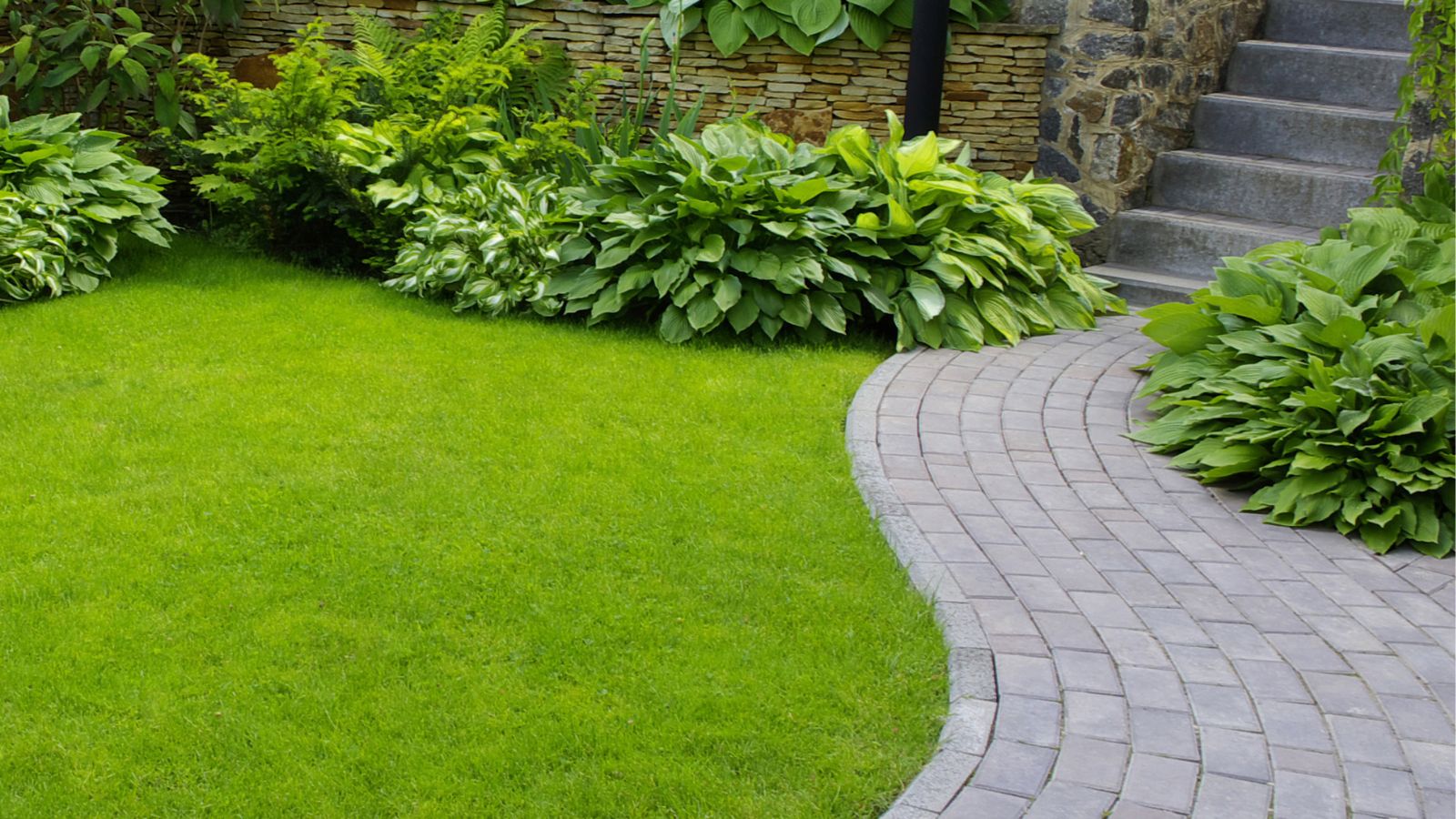 These leafy plants are ideal for shaded areas.
These leafy plants are ideal for shaded areas. Hostas bring lush leaves to fill out the partially shaded foundation or border. Whether broad, strappy, or curly, they offer textural contrast and attractive foliage from blue-green to chartreuse to variegated.
Use large varieties as single specimens among other shade-loving perennials or line a bed edge beneath shrubs with the sculptural plants.
In early summer, tall bloom scapes in lavender or white float above the mounding leaves and attract hummingbirds. Hostas benefit from morning sun, especially those with bright or variegated foliage, to retain their vibrance. Provide well-draining soil and aim for even moisture, especially early in the growing season, for the best vigor.
Daylilies
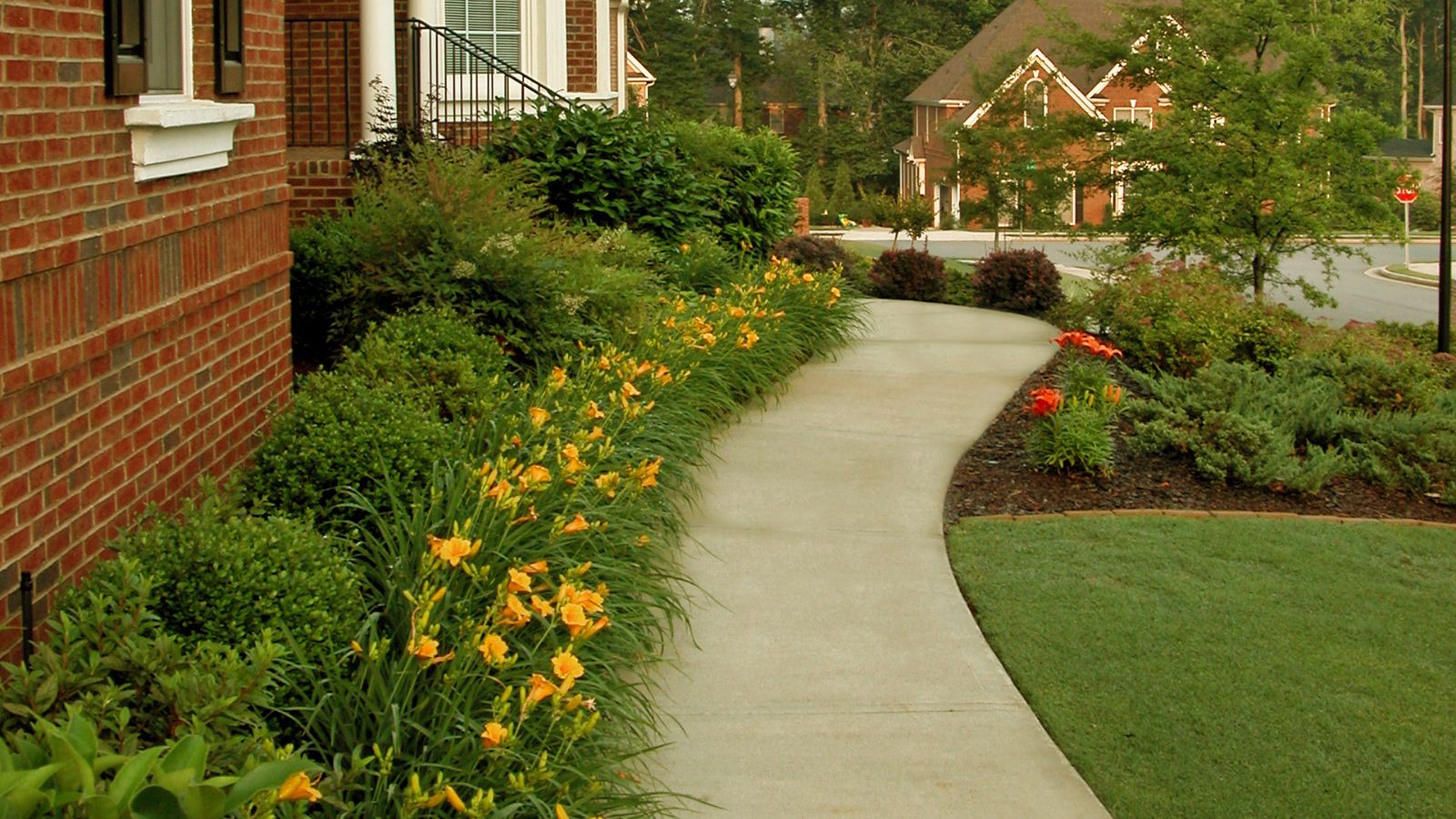 These perennials flower prolifically.
These perennials flower prolifically. Daylilies bring a burst of color throughout the warm season. The tough perennials grow in a range of conditions and supply a succession of sun-loving blooms until frost. Some species are so vigorous they are classed as invasive.
Flower stems rise tall above mounds of strappy, bladed leaves in green or blue-green. Daylilies tolerate various soil conditions. They’ll do best in organic, evenly moist soils but adapt readily to lesser soils. Give daylilies full sun for best flowering.
Daylilies need little care, making them a low-maintenance, high-color perennial plant for the front of the house. For a tidy appearance, deadhead spent blooms and stems.
Switchgrass
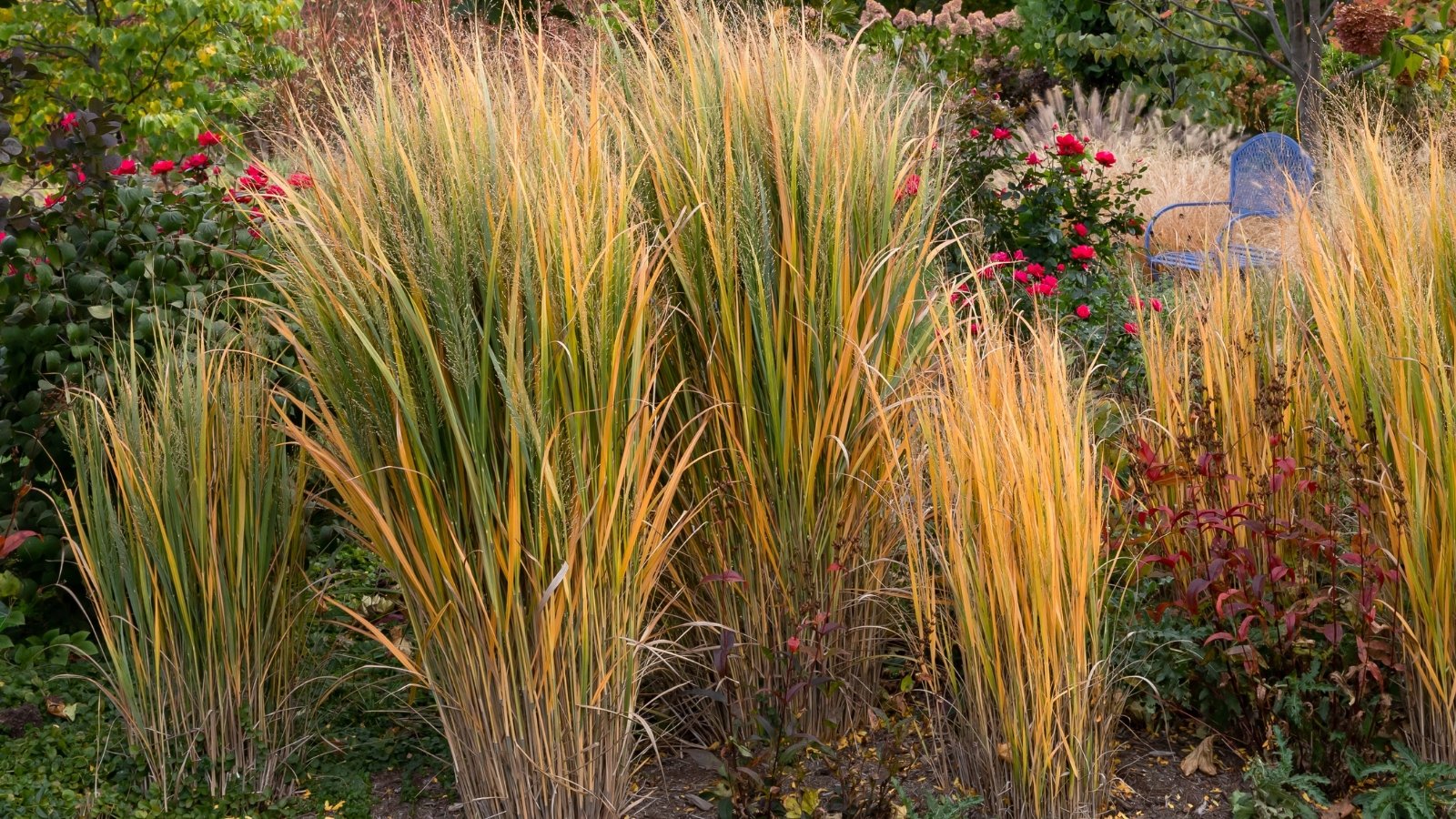 Ornamental grasses are a great low-maintenance option.
Ornamental grasses are a great low-maintenance option.Switchgrass and other ornamental grasses add graceful movement and texture to perennial beds at the front of the house. They soften structural evergreens and loosen the composition.
Switchgrass is a North American native prairie grass that grows across soil types, moisture levels, and light conditions. Look to ‘Northwind’ as an upright, columnar variety with fine olive-green blades. Leaves turn yellow and tawny in the fall for lasting appeal. ‘Cheyenne Sky’ is a rich variety that begins blue-green and transitions to wine red in early summer, with plumes to match.
Instead of cutting back grasses in the fall, keep them intact through the winter to enjoy their unique forms, plumes, and seed heads as seasonal interest. The seedheads provide forage for songbirds, and the blades shelter for overwintering insects and wildlife. Native ornamental grasses and their cultivars suit their growing areas without the need for extra resources.
Ornamental Allium
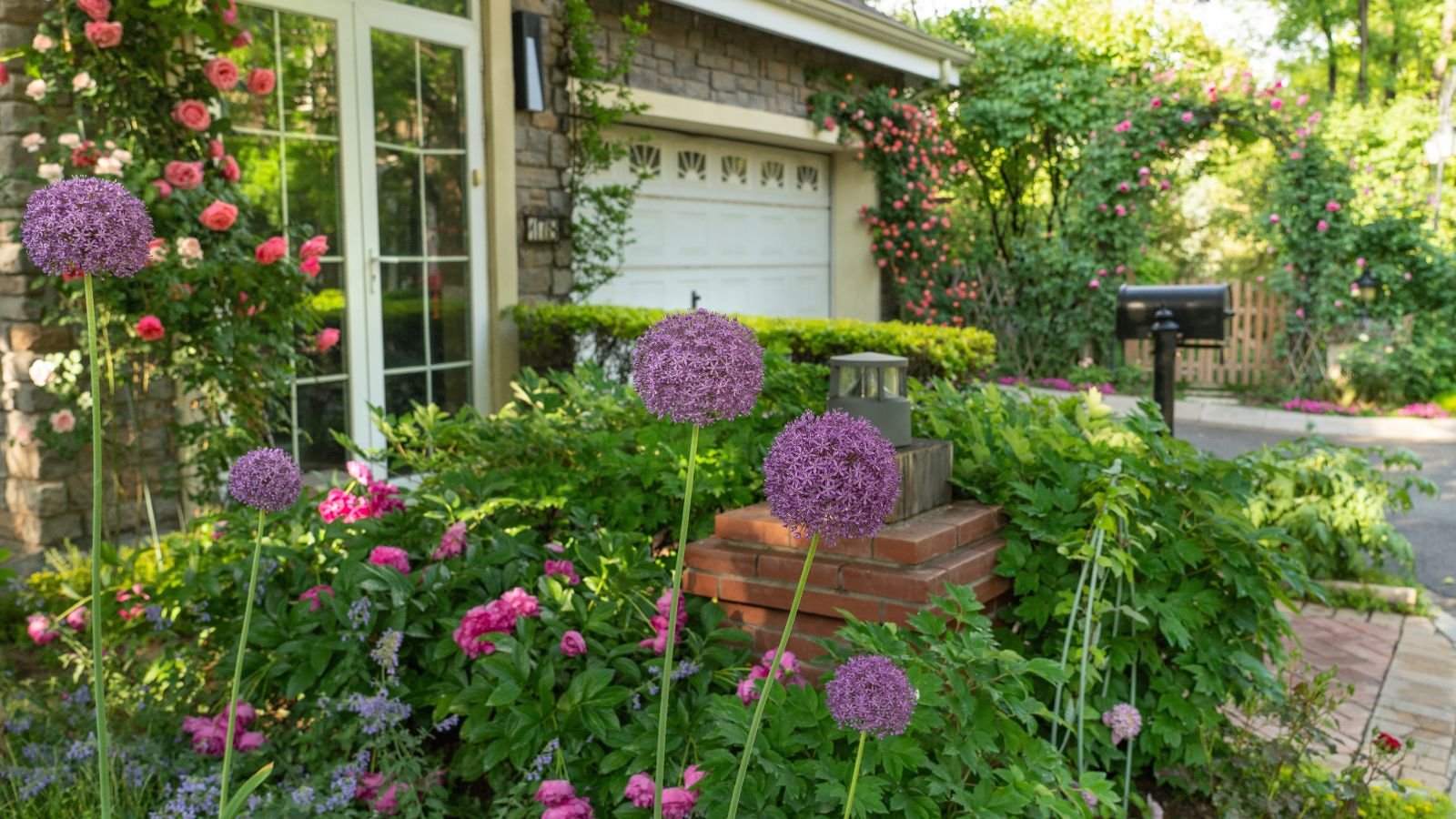 Alliums have beautiful globe-shaped flowers.
Alliums have beautiful globe-shaped flowers. Ornamental alliums bridge spring and summer with varying bloom sizes in blue, pink, purple, white, and yellow. Their dramatic flower clusters emerge as spheres for high form. Giant ornamental onions produce towering rounds that average three to five feet tall, depending on the variety. Others are more compact and fit a range of garden spaces with a profusion of little globes.
‘Globemaster’ is a hallmark of giant ornamental alliums with spheres of purple florets that measure 10 inches across. Stout stems hold the impressive globes upright. After flowering, the petals dry and turn tawny for lasting interest into summer. ‘Globemaster’ is a Royal Horticultural Society Award of Garden Merit recipient.
‘Powder Puff’ features the high ornament of purple-floret spheres in a more compact, cold-hardy form. This ornamental onion bears deep purple, tennis-ball-sized blooms in late spring and early summer for the front of the house perennial border.
Pollinators and other beneficial insects flock to the vibrant rounds. Plant the bulbs in the fall, or opt for an herbaceous perennial variety like ‘Millennium.’ They do best in well-drained soil and with extra winter mulch in lower hardiness zones.
Foxglove
 The tall flower spikes stand out in the garden.
The tall flower spikes stand out in the garden. Foxgloves are showstoppers in a mass or group in spring and summer. Their tall, bloom-lined stems ooze curb appeal to usher in spring and summer. Purple, rose, peach, and creamy white bell flowers with freckled throats draw bumblebees.
They put on a showy display until temperatures rise (in areas with hot summers, treat them as cool-season annuals). While not as long-lasting as other perennials for the front of the house, their seasonal show is worth planting. They grow best in moist, organically rich soils with good drainage.
Agapanthus
 These beautiful plants look great in containers.
These beautiful plants look great in containers. With their airy blooms, agapanthus make excellent perennial plants for the front of your house. Agapanthus produces rounded clusters of bell blooms atop tall stems. Depending on the cultivar, agapanthus flowers are blue, lavender, or white and rise above deep green, strappy leaves.
The evergreen, arching leaves are thick and glossy, attractive even when the plants aren’t in flower. Agapanthus is an adaptable perennial native to southern Africa, and tolerates drought and heat. Ideal soils are fertile, moist, and well-drained. In cold climates, overwinter agapanthus indoors, where it grows as a houseplant in bright light.
From tall varieties like ‘Queen of the Nile’ to dense, floriferous dwarfs like ‘Peter Pan,’ the range of sizes is versatile. ‘Fireworks’ holds Award of Garden Merit status with full clusters of bright white petals with violet-blue throats. The huge umbels’ top stems reach over two feet tall.
Heuchera
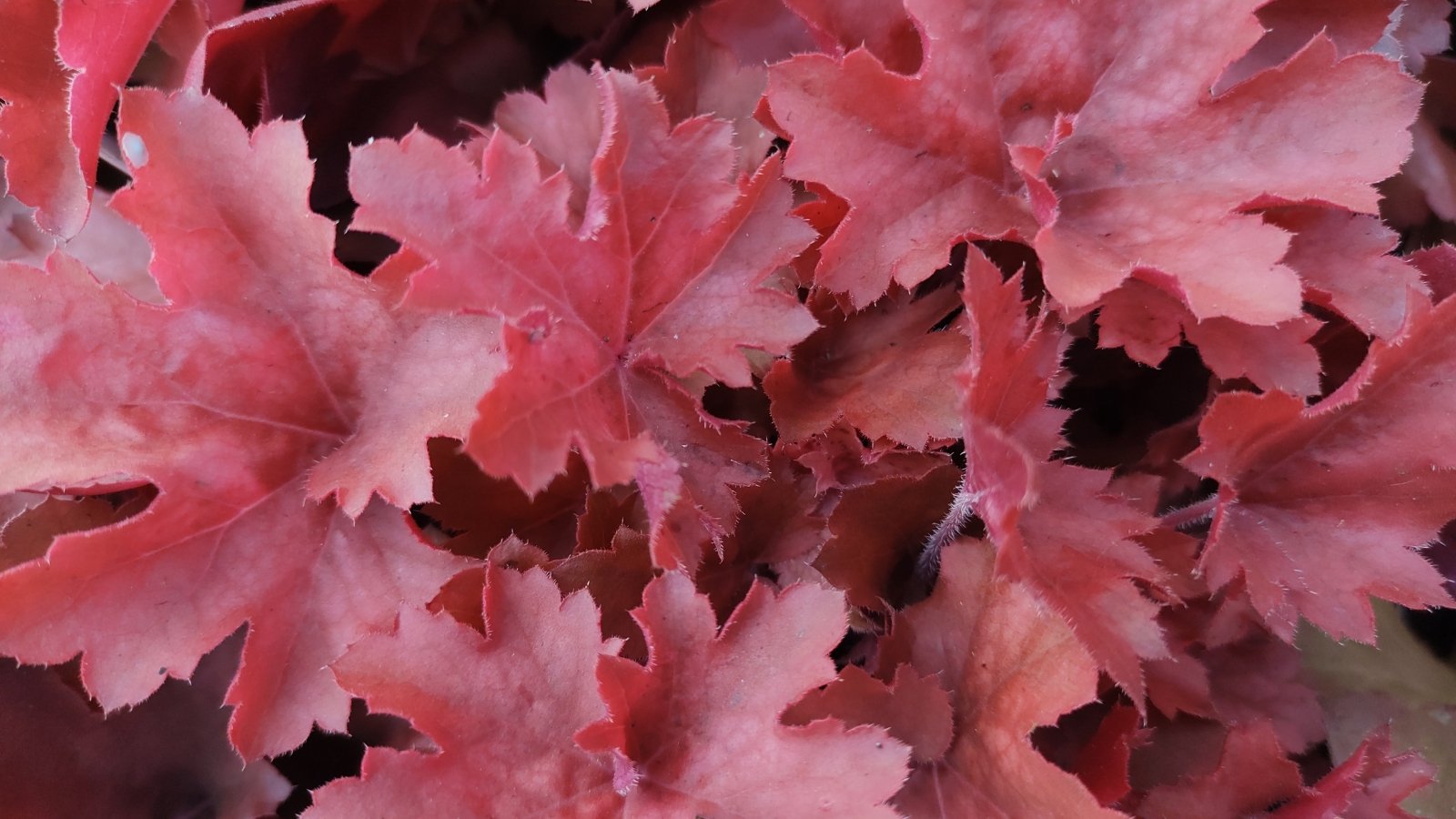 Coral bells come with colorful foliage that stands out in the garden.
Coral bells come with colorful foliage that stands out in the garden. Heuchera, or coral bells, are North American natives with colorful, shapely leaves. Hybrids have lime, purple, bronze, black, red, and orange foliage, often in mottled tones. They heighten visual interest and contrast in the front of the border.
In summer, airy bloom sprays rise above the mounding leaves. Semi-evergreen in warm areas, the herbaceous perennials show a fresh flush of foliage in spring.
Heuchera does best in rich, organic, well-drained soils. Morning sun with afternoon shade protection in hot climates is best for coral bells.
Catmint
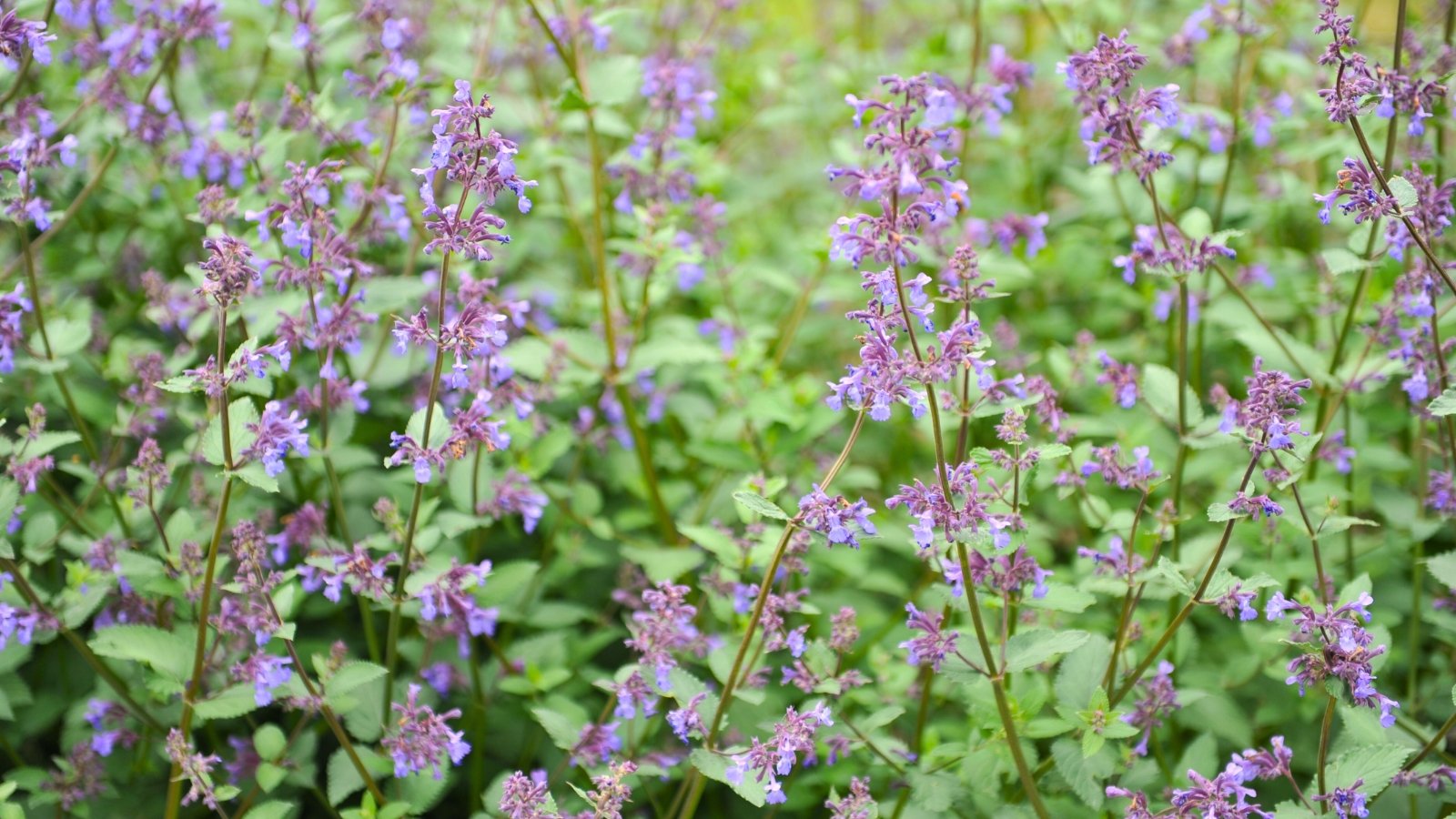 These perennials don’t require much attention to thrive.
These perennials don’t require much attention to thrive. Catmint produces a cloud of purple blooms and is beautiful dotting the front of the house in early summer. Nepeta has soft, mounding gray-green foliage and spikes of tubular flowers throughout the warm season.
The aromatic leaves contain essential oils that repel certain garden pests, making a good companion among edibles and other ornamentals. It also attracts pollinators and beneficial insects.
‘Walker’s Low’ holds Award of Garden Merit status. The lavender-blue blooms begin in early summer and last most of the season. The variety tolerates humidity, heat, and salty conditions better than other selections and retains a mounding form.
‘Cat’s Meow’ is a dwarf secleciotn with a neat habit all season. It has well-branching stems with robust blooming among small, gray-green leaves. It bears a low-growing but big bloom display.
Robust and versatile, catmint needs few resources to thrive. Deadhead spent flower spikes or shear plants after blooming to encourage reflowering more quickly.
Acanthus
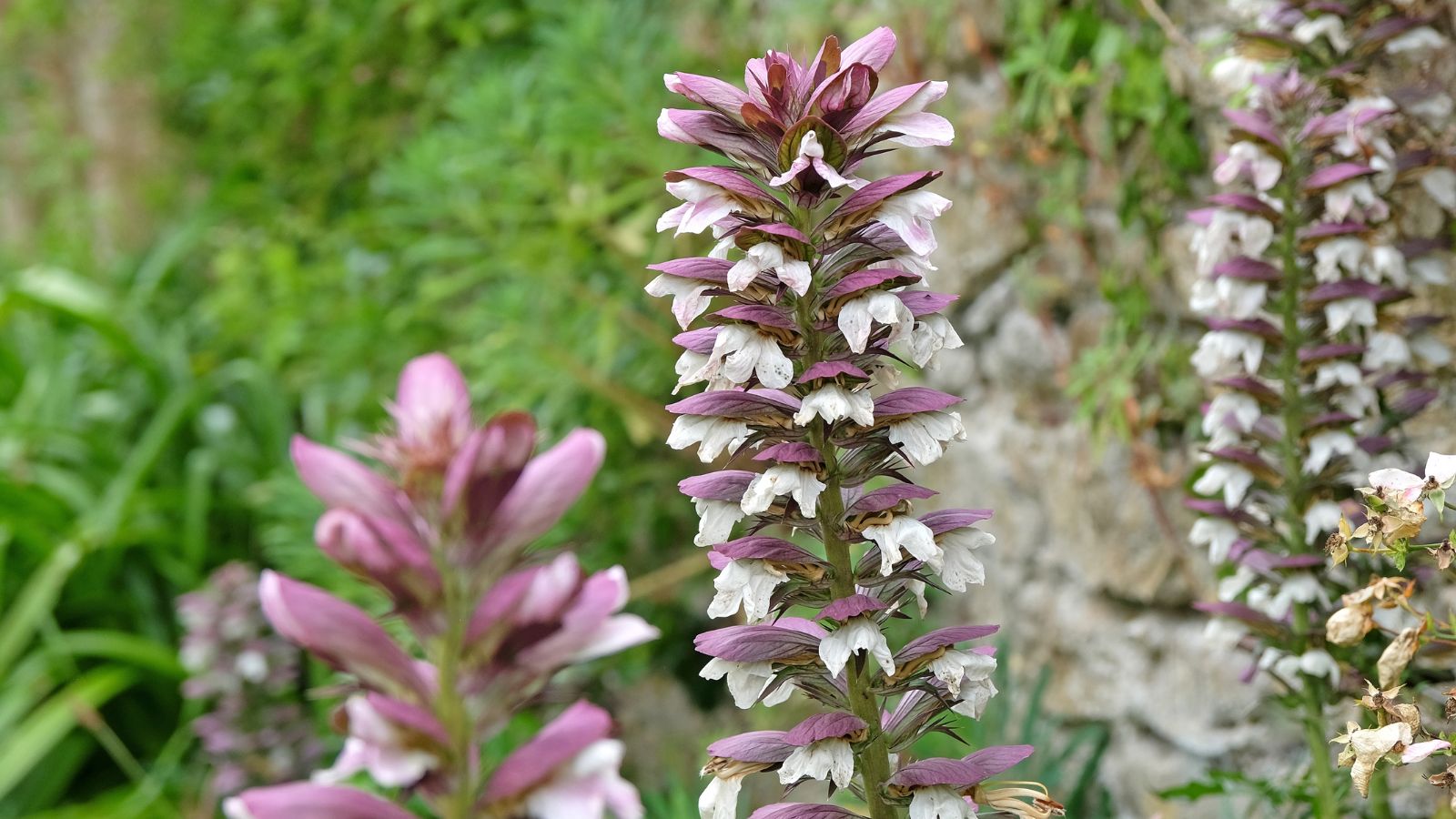 The bold blooms immediately catch the eye.
The bold blooms immediately catch the eye. Acanthus boasts architectural foliage with long, broad leaves in dark, glossy green. The perennial thrives in warm climates, where deeply cut leaves with soft spines unfurl in spring with textural interest. Acanthus makes a handsome statement among foundation plants or highlighting an entrance.
In addition to their structural foliage, the Mediterranean native produces tall spikes of pinkish-white flowers with deep purple bracts. The bold spikes emerge in summer and last for weeks.
Acanthus grows with little maintenance in both dry and moist soils as long as they’re well-draining. They prefer a spot out of direct afternoon sun.
Hardy Hibiscus
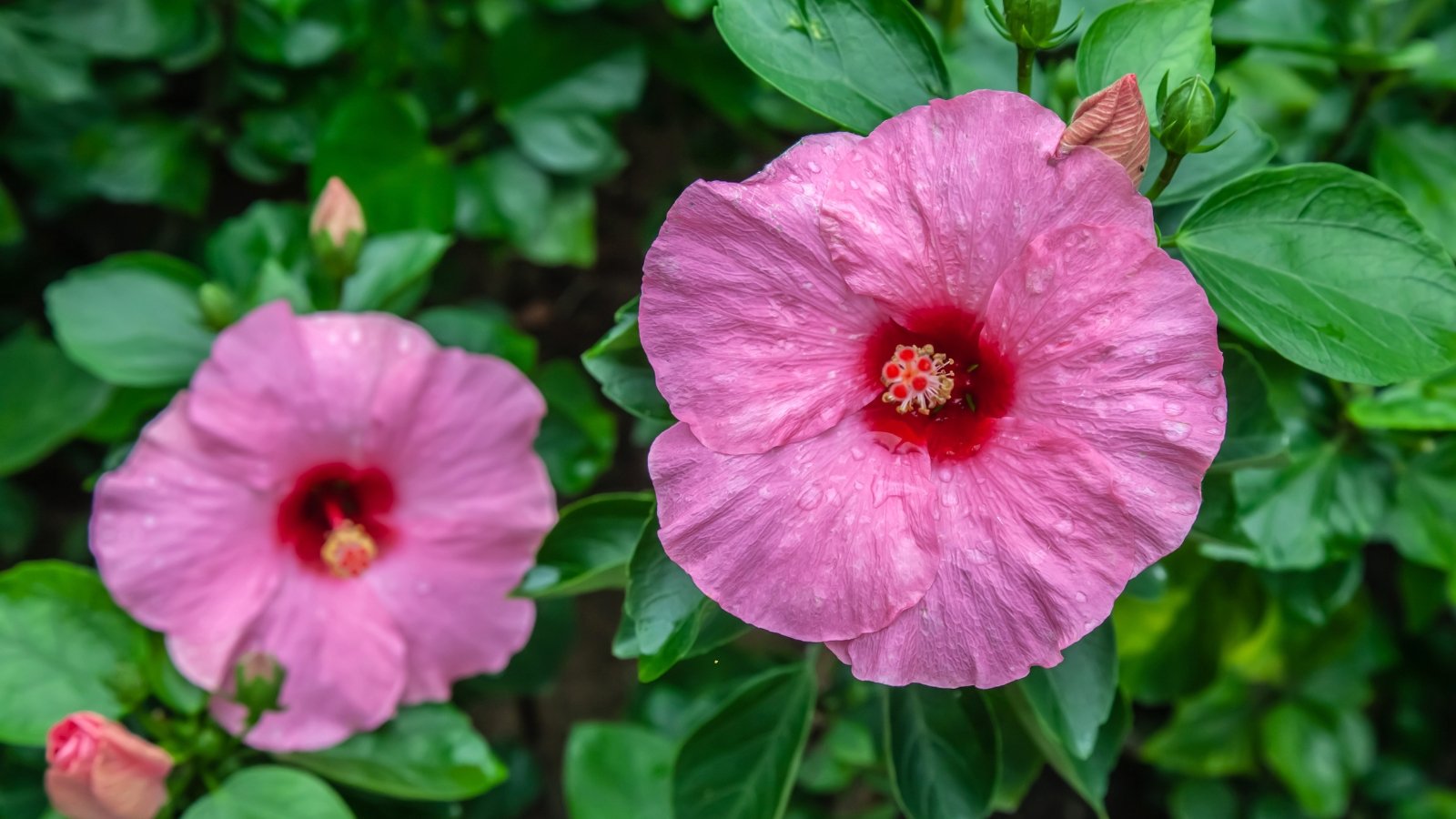 Look for a variety in your favorite color.
Look for a variety in your favorite color. Hardy hibiscus offers huge disc flowers and rich foliage. North American native mallows include H. moscheutos, H. laevis, and H. coccineus, with hardy hybrids that feature improved landscape durability and exceptional flowers and leaves.
Flowers emerge from midsummer through fall and range from pale pink to deep scarlet. Although they last only a day, they produce numerous blooms simultaneously for continual flowering. Palmate leaves range from green to deep plum to nearly black.
Mallows tolerate different soil types but rely on consistent, evenly moist soils and won’t withstand prolonged dry spells.
Another Hibiscus that makes a lovely perennial for the front of the house is rose of Sharon (H. syriacus). The vigorous shrub has small hibiscus blooms in blue, lavender, pink, or white. Larger and shrubbier than the perennial mallows and tropical hibiscus, the plentiful flowers are somewhat smaller.
Also called althea or common hibiscus, rose of Sharon has a carefree habit and can grow up to 12 feet tall. I tends to invade natural areas in parts of North America. The adaptable perennials are generally hardy in zones 5-9 and tolerate heat, humidity, coastal, and urban situations.
Daffodils
 These classic spring flowers are a front garden staple.
These classic spring flowers are a front garden staple. Spring-flowering bulbs make gorgeous perennial plants for the front of your house. Tuck them in during fall planting and await the seasonal surprise as the weather warms. Their abundant blooms are eye-catching in a sweep and even in a small group.
Among the showiest and easiest perennial bulbs are daffodils, bursting into color in late winter and early spring. Their trumpet blooms and cups appear in yellow, white, apricot, and pink.
Look to early, mid, and late-season bloomers for combinations of staggered seasonal flowers. Daffodils shine on their own or pair beautifully with tulips, hyacinths, and other spring favorites.
After blooming, let the daffodil leaves persist until they turn yellow and die back as temperatures rise. Keeping the leaves intact lets bulbs continue photosynthesizing to store as much energy as possible for the next growing season.


 1 day ago
11
1 day ago
11
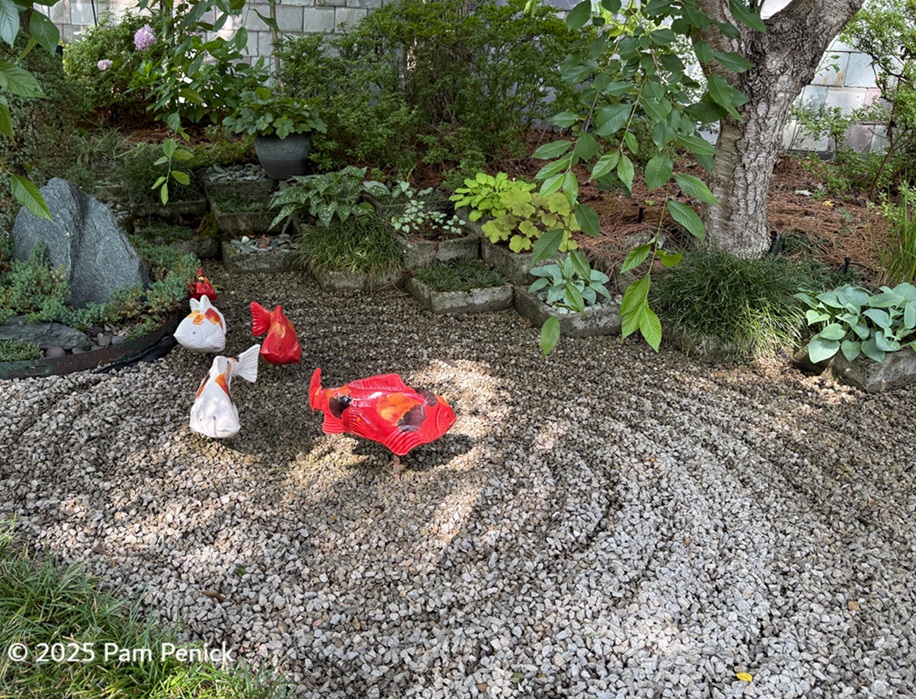
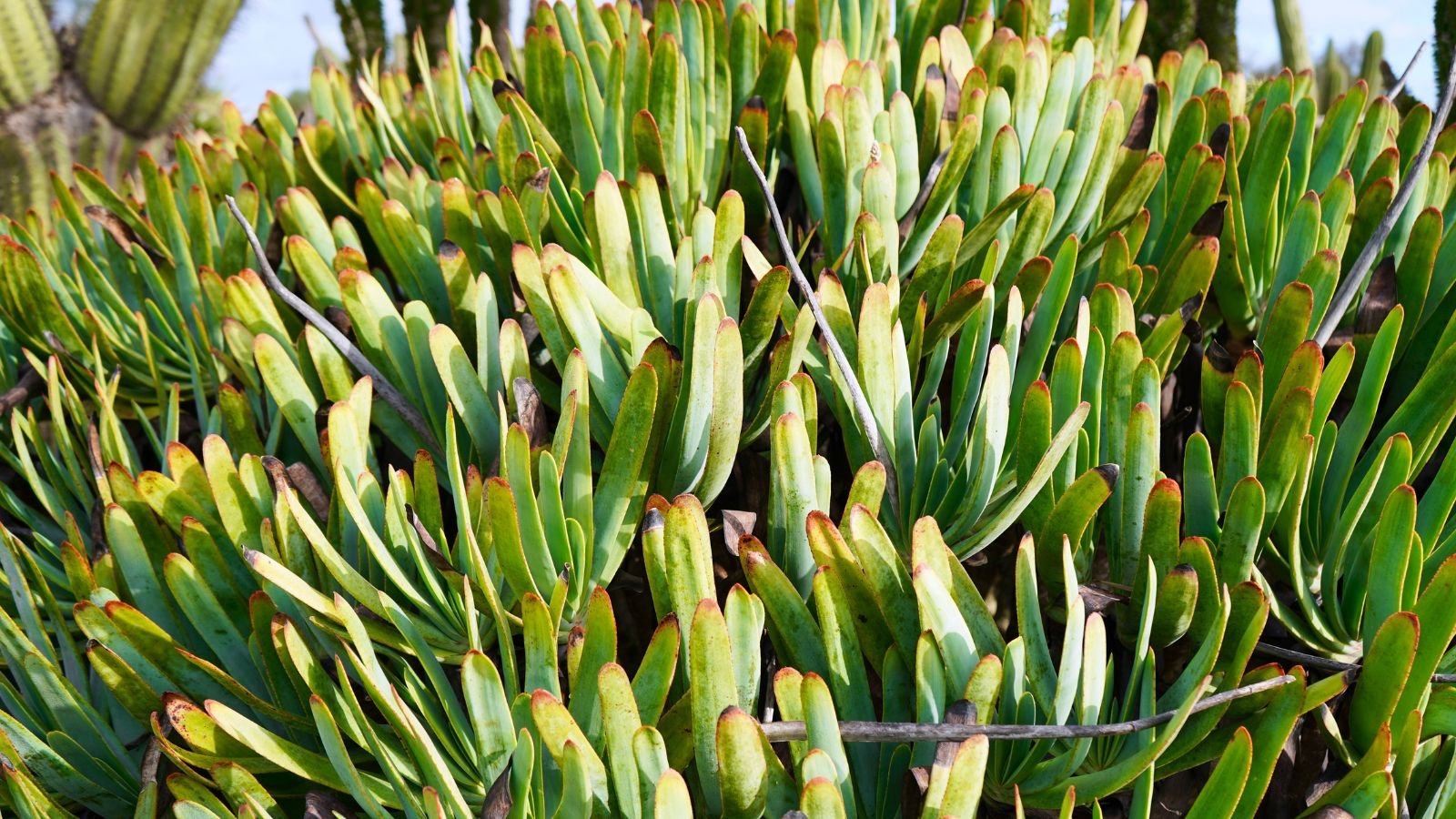



















 English (US) ·
English (US) ·  French (CA) ·
French (CA) ·